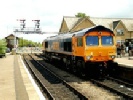Archive Section




By John Lunn
The party consisting of 10 members, including Ms. Sarah Kendall, our lady member, met at St Pancras to catch the 07.45 to Chesterfield. It had been arranged for members to ride on the footplate of the H.S.T. during the course of the journey. Noted in. Derby Technical Centre was the Metro Cammell class 151 Sprinter and in Derby Station, we also had a good view of a brand new Leyland built class 155. With several ex Midland men in the group, various details were pointed out whilst en route. The approach to Chesterfield was, of course, marked by the distinctive crooked spire and off the train we were met by a strong smell of liquorice from the nearby Trebor sweet factory. A small embarrassment took place in the station car park when it was discovered that we had two buses to take us to Markham, one having been arranged by our President, Mr. Greaves; this fact had not been relayed to me, the other bus, from the East Midland Co., had been arranged by our vice-
On arrival at Markham, we were taken to the training officer by the time clerk, and introduced to Mr Smith, the training officer, who in turn, introduced us to our other guide, Mr Davis, the personnel manager. These two gentlemen gave us a brief description of the colliery before taking us to change. After changing, we were taken to the rescue room to be kited out with helmet, gloves, lamp, kneeling pads and personal life saver; this last item being an oxygen mask that fitted into a can about the size of a small flask. Special instruction was given in its use and Mr Smith promised to pay us 10 each if it had to be used in anger. Also at this time, we were all issued two numbered brass checks, one of which was to be given up at the pit head and the other retained until returning to the surface. This system applies to all people underground. These preliminaries over, we then handed in all our battery driven watches, lighters, matches etc. to comply with safety requirements and then headed for the pit head. Entry to the shaft head was via several, for the want of a better description, wind tunnels, these being divided up by heavy doors, it being near impossible to open the second door without the first one being closed; the wind pressure being due to the air being forced into the shaft. Before entering the cage, we were all subjected to a body search, all that is except Sarah who was taken on trust. Descent in the cage was to a depth of 400 yards and was as smooth as any hotel lift, though near the bottom of the shaft, stretching in the cables was noticeable.
After leaving the cage, we carried on either on foot or on the manriders, these being no more than conveyor belts for people. (A good idea for truculent commuters, perhaps?) On the first manrider, we dropped quite a bit more before getting off and walking to the next manrider. On the next manrider, we started to rise again; we had, in fact, dropped down to a depth of 700 yards before rising again and we were in fact following the Inkersall Fault. The service tunnels themselves, were of quite large section and lined with small sheets of corrugated iron, held in place by steel braces at frequent intervals. Despite this, a number of spots were pointed out where the ceiling had tried to collapse; some places being so bad as to require additional support with wooden pit props. All through the tunnels, on the floor and in liberally packed bags in holes all along the tunnel walls and roof, is a greyish powder which is used to stifle any explosions; the powder has to be replenished once a week by law. Throughout all the tunnels was the mine railway system, which was used mainly for supplying stores to the coalface. The system was entirely rope worked but plans to modernise the system with electric locomotives and some form of track circuit and timetable control, was being planned.
After travelling approximately 1/4 mile, we reached the end of the tunnel. At this point, we came across a boring machine, which was enlarging the entrance to the coalface to the full tunnel size. To reach the coalface itself, we had to pass through a very low, narrow passage, lined and supported on short 4 x 4 timbers. This opened out into the 80's coal face, the working face being approximately 300 yards long and was lined as far as we could see by jacks and rams. These supported the ceiling and forced the working face forward as coal was cut away. Illumination on the face was very good, being provided by fluorescent tubes mounted on the jacks. Only 10 men are employed on the coal face itself and of these, I noticed one carrying a traditional miners lamp. This would have been for gas detection. The pale light from this lamp was in strong contrast to the electric lights around us and the lamps on our helmets; it gave me at least an idea of what a coalmine would have been like before electric lamps. The coal itself was cut by a cutter of some 5 feet in diameter, travelling back and forth across the full length of the face, the cut coal falling onto a continuous conveyor and being taken away. The entire operation was being sprayed with water in order to minimise the amount of dust in the atmosphere. I should point out that when we entered the coal face and first moved along under the jacks, we had to adopt a stooping stance, but as we progressed the ceiling became gradually lower until for the last 40 or so yards, we had to travel on our hands and knees. I believe at one stage, a small incident took place whilst on the face. I was at some distance so do not know the details but I did see a couple of ceiling jacks being lowered, followed by what I believe was a loss of hydraulic pressure, and then I believe some of the ceiling came away, causing some consternation. The situation was however soon resolved.
In going through the mine tunnels and along the coalface, it was obvious that all the men working below ground were pleased to see visitors taking an interest in their work and all showed obvious pride and pleasure in their work, despite being in often cramped and hot positions and always dirty. Our return to the surface was much as the journey down had been. The only event being the failure of one of the manriders (the N.C.B. regret!).
The return to the open air was very welcome, the sharp sunlight causing a shock to the eyes when first stepping out; the air too seemed much sweeter. On returning to the lamp room, our equipment was handed in, the second brass check, which each of us carried underground, had to be handed in at the pit head. After all the formalities, we then went to the pit head baths for a shower, special arrangements having been made for Sarah to wash. After washing we returned to the conference room where lunch and a very welcome cup of tea was waiting for us. After lunch and a further talk with our two guides, we returned to the bus which had grown somewhat in our absence to return to Chesterfield for the 15.08 to London.
NOTES: Markham Colliery originally opened in 1882. As of 1987, it has 30 million tons of reserves which will give a life of a further 15 years. The men on Blackshale seam produce about 1000 tons per shift. The coal is of good quality , being hard and shiny; the bulk of the coal is used in power stations.